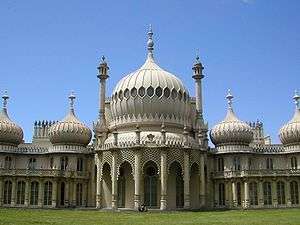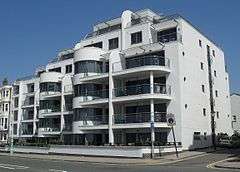Whitehawk Hill transmitting station
|
| |
| Mast height | 148 feet (45 m) |
|---|---|
| Tower height | 182 feet (55 m) |
| Coordinates | 50°50′N 0°07′W / 50.83°N 0.11°WCoordinates: 50°50′N 0°07′W / 50.83°N 0.11°W |
| Grid reference | TQ32960452 |
| Built | 1959 |
| BBC region | BBC South East |
| ITV region | ITV Meridian |
| Local TV service | Latest TV |
The Whitehawk Hill transmitting station (also known as the Whitehawk transmitting station) is a broadcasting and telecommunications facility located at Whitehawk, an eastern suburb of Brighton in the English city of Brighton and Hove. It is the city's main transmission facility for television and radio signals.[1] It broadcasts digital television, FM and DAB radio to the coastal city of Brighton and Hove and to surrounding areas along the Sussex coast. It stopped broadcasting analogue television when the digital switchover occurred locally in March 2012.
Services broadcast include BBC One (South East), BBC Two, ITV (Meridian), Channel 4, BBC national radio stations, BBC Sussex and Heart Sussex.
History
A radar station was opened on the high ground of Whitehawk Hill, to the east of central Brighton, during World War II. Meanwhile, television broadcasts first reached the town in 1953 when a relay transmitter was erected on Truleigh Hill, several miles to the west on the South Downs.[1] On 5 April 1959, after the wartime facility was demolished, a 148-foot (45 m) transmitter was opened at Whitehawk. It took a feed from the Crystal Palace transmitting station until 14 April 1962; after that, signals were relayed from the Rowridge transmitting station. The original VHF signal was accompanied by colour UHF transmissions from 21 September 1970 (BBC1 and BBC2 only) until the VHF 405-line TV transmissions from this site ceased in 1983. UHF signals for ITV and Channel 4 followed from 28 April 1972 and 17 May 1983 respectively.[1] Radio broadcasts started on 13 March 1967, in mono only; stereo transmissions commenced on 4 November 1972. From the beginning, signals were relayed from the Wrotham transmitting station;[1] this arrangement continues as of 2016.[2]
The original mast was replaced in 1983 by the present structure, which stood alongside it for a short time until the earlier mast was demolished. The present mast is also 148 feet (45 m) tall; it reaches a height of 182 feet (55 m) when the UHF aerial is taken into account. Whitehawk Hill itself is 396 feet (121 m) above sea level. In 1990, the transmitting station was reported to serve 400,000 people and was supported by relay transmitters at several locations around Brighton: Patcham, Ovingdean and Saltdean (all installed in 1982–83), and Coldean and the North Laine area of central Brighton (both planned for 1990 but delayed).[1]
Services available
Analogue radio
| Frequency | kW | Service |
|---|---|---|
| 99.7 MHz | 0.25 | BBC Radio 1 (FM) |
| 90.1 MHz | 0.25 | BBC Radio 2 (FM) |
| 92.3 MHz | 0.25 | BBC Radio 3 (FM) |
| 94.5 MHz | 0.25 | BBC Radio 4 (FM) |
| 693 kHz | 1 | BBC Radio 5 Live (AM) |
| 95.3 MHz | 0.5 | BBC Sussex (FM) |
| 101.9 MHz | 0.2 | Classic FM |
| 103.5 MHz | 0.45 | Heart Sussex |
The coverage area of BBC Sussex extends to Worthing, Haywards Heath, Uckfield and Eastbourne. Other stations have smaller coverage areas from this transmitter.[3]
Digital radio
| Frequency | Block | kW | Operator |
|---|---|---|---|
| 218.640 MHz | 11B | 0.79 | Sussex Coast |
| 222.064 MHz | 11D | 0.5 | Digital One |
| 225.648 MHz | 12B | 2 | BBC National DAB |
The Sussex Coast DAB ensemble includes BBC Sussex, Capital, Gaydio, Gold Sussex, Heart Sussex, Pop Up Radio, Smile Sussex and XFM.[2][4]
Digital televisionThe transmitter (seen here from the Palace Pier) stands on high ground to the east of the city. The transmitter provides Freeview television to 96,000 households. Since 28 August 2014, a local television station called Latest TV has been broadcast from LTVmux.[5]
Analogue televisionAnalogue television transmissions were turned off in two stages—on 7 March 2012 and 21 March 2012.[5] At this time, the local BBC service broadcast from the transmitter was changed from BBC South to BBC South East.[6]
References
Bibliography
External links |

.jpg)
.jpg)
